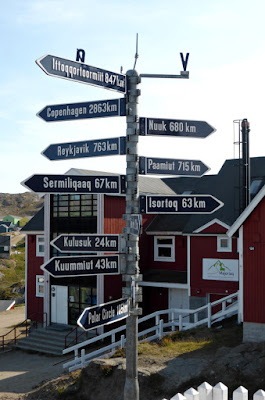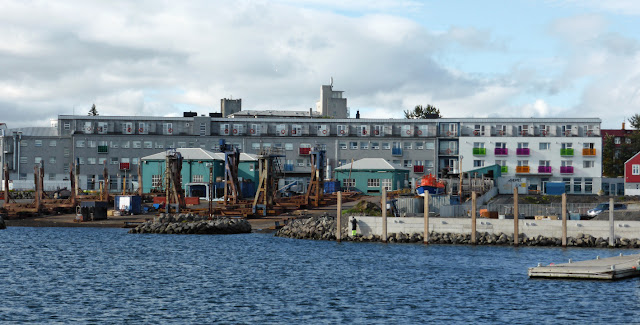It didn't look like a big boat, but it did the job, especially because we were blessed by another sunny day. Being susceptible to motion sickness, I had staggered two bonine tablets, one before and one after breakfast. I felt a bit rocky at the start even so, but after half an hour I was doing better and standing up in the bow with several others. Joan, monitoring the sunlit ocean mists, spotted our first blow (whale exhalation) in the distance. This photo, not the actual first blow, gives an idea of what we were searching for.
Then there were two.
As we drew closer I started taking photos. Our guides, Katie and Drew, identified the whales as humpbacks.
I couldn't call it a chase, but our boat puttered in the whales' direction. Of course, we wanted to avoid disrupting the whales' normal feeding behavior; they would dive and stay submerged for minutes at a time while we scanned 360° to spot where they would pop up.
The two whales, a mom and her calf, stayed close to each other. The young stay with their mothers for three to four years.
These are my best images. First, the two whales cruising side by side near our boat.
They were briefly close enough for us to see their distinctive large front flippers through the water.
The tail flukes of the larger whale. The patterns on the underside are distinctive "fingerprints" which allow individual humpbacks to be recognized at locations thousands of miles apart.
The younger whale didn't have much patterning yet.
OK, one more tail photo.
After having stood out on the bow for a long time I retreated to the middle of the boat, sat down on a bench, and held onto the guardrail, which felt very good. I remained seated until we docked.
We nourished ourselves at the lunch buffet back at the Hotel Angmagssalik, and, fortified, spent the afternoon walking through Tasiilaq. Our first stop was a workshop where artisans crafted items for sale. Power tools working on wood and bone gave the small space a mixed scent of sawdust and dental drilling. (The letters on the building should spell "kunst," Danish for "art," but the letters were installed wrong.)
Note that marine mammal fur or ivory (including bone) cannot be taken into the United States. This meant that we couldn't consider things made from polar bear, seal, whale, or other such. Yes, the polar bear, which spends much of its time on the ocean ice, and can swim for amazing distances, is considered a marine mammal.
The next stop was the Ammassalik museum, specializing in east Greenlandic items.
In a center case were examples of eastern dress,
less ornate that west Greenlandic, as shown here in Qaqortok from 2013. The east Greenlanders consider this western gear to be a waste of material.
Two cases showed various eastern handiwork. Due to reflections in the glass, the best I can show is one corner of a case.
Hanging on the far wall was a traditional kayak, made mostly from driftwood and seals. Note the skinny paddle strapped to the bow. Such a paddle makes less noise when sneaking up to a seal hauled out on the ice.For those of us up to a challenge, the museum had a kayak simulator, a narrow wooden platform with a rounded base. Could we paddle and keep our balance at the same time? I couldn't, nor anyone else.
Next to the old church was a sod house, winter quarters for the dark, frigid north.
The entrance is more modern. Traditionally there would be a sod tunnel, angled downward so that the heat provided by seal oil lamps and a mass of human bodies wouldn't escape.
We stooped and entered the sod house, where an older Greenlandic gent answered questions. It was difficult for us to imagine a large group living for months in such intimate proximity.
Then our group continued on to the tourist center, ice cream shop, and gift shop all in one building. Outside, distance markers.
We all had ice cream, and Joan bought a pair of small earrings, perhaps an inch tall.
These represent a tupilak, a being made by a shaman or sorcerer, who had the power to create a living tupilak from dead items of different natures, often parts of animals, such a seal plus a human being. The tupilak could be sent by its creator to carry out acts of revenge or other evil; however, this had to be carefully judged, because a more powerful sorcerer could turn the tupilak around to attack the sender.
Several of us were relaxing on the outside deck when one of our company lost her clip-on sunglasses through a gap in the boards. Katie and Drew jumped into action.
It took a while, but with four hands and three implements the lenses were recovered!
Our walk continued past the hospital and the school, and then turned up the coast. The area close to town had several clusters of chained sled dogs
and parked sleds.
Then it was time to return to the hotel. Along the way we passed this out-of-season traffic warning.
At the hotel we were treated to a talk by Rassmuss, a young Danish man now informally adopted into his Greenlandic girlfriend's family. He discussed cultural differences, the extended family dynamic in east Greenland, outdoor sports (snowmobile, dog-sledding), winter isolation, and other aspects of life in Greenland, informed by both his several years in Greenland and his Danish upbringing. Sometimes the two worlds created a tug-of-war within him, for example, the treatment of sled dogs that are past their working years. They aren't pets, and they consume food resources otherwise available to working dogs, so in Greenland they are killed when they can no longer work. Rassmuss understood the economic imperative, but didn't appear to be completely comfortable with the practice.
After dinner -- no program -- a chance to rest! Tomorrow our NatHab group will travel to Base Camp, the four-night capstone of this adventure.






























































